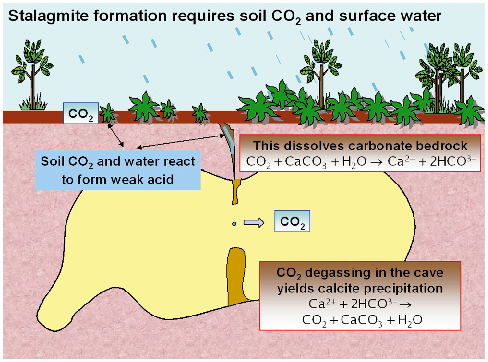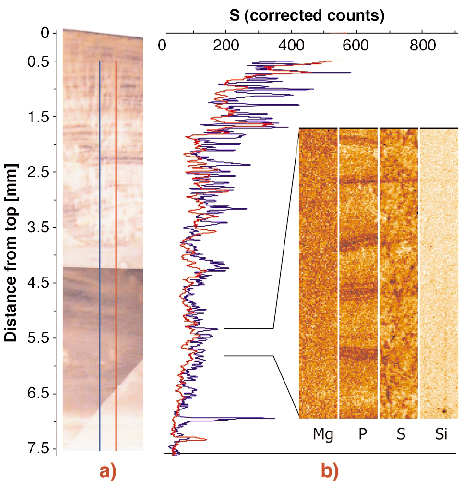- Home
- Users & Science
- Scientific Documentation
- ESRF Highlights
- ESRF Highlights 2004
- X-ray Imaging
- Variations in Atmospheric Sulphate Recorded in Stalagmites
Variations in Atmospheric Sulphate Recorded in Stalagmites
Our understanding of secular variation in sulphate aerosol concentration comes primarily from ice cores. The rise in sulphur concentration during the last 150 years detected in Greenland and Alpine ice cores reflects increasing twentieth century anthropogenic load. We need archives in mid-latitudes and at low altitudes to improve our knowledge about the role of sulphate aerosols in altering regional radiative forcing and climate. By applying synchrotron radiation micro-XRF (X-ray fluorescence) we found such an archive in calcium carbonate speleothems, mineral deposits formed in caves.
Speleothem-forming environments act as S archives because a significant fraction of atmospheric precipitation enters the karst aquifer rapidly. Rainwater and soil PCO2 combine to form the weak carbonic acid, which dissolves the carbonate rock. Within the karstic aquifer, flowpaths are commonly short (typically 5-50 m), and when the drip waters enter the cave they release CO2 to the cave atmosphere and precipitate calcium carbonate at the top of the growing speleothems (Figure 137). Seasonal variability of trace element concentration in stalagmites can result in visible annual laminae [1]. Annually laminated stalagmites are the best specimens for synchrotron radiation analyses because the chronology of scans and maps (determined by counting back in time each visible lamina from the year of removal) can be precisely reconstructed.
 |
|
Fig. 137: Scheme illustrating how stalagmites capture atmospheric changes. |
We applied X-ray micro-fluorescence coupled with X-ray absorption near edge structure spectroscopy (XANES) to detect sulphate concentration changes in the top 160 years of annually laminated stalagmite ER78 from Grotta di Ernesto, a cave located at 1167 m above sea level in north-eastern Italy. On a double polished, 200 µm-thick wafer, two parallel 7 mm-long scans (300 µm apart), dated from 1840 to 1995 AD, were analysed at ID21. The specimen was placed in the microscope chamber operated at a pressure of 10-5 mbar. A high-resolution double crystal Si 111 monochromator allowed selection of the energy relative to different coordination for sulphur, and a Fresnel zone plate generated an X-ray probe of sub-µm diameter. We reached 1 µm-diameter analytical spots, with 1 µm steps for scans and 2 x 2 µm pixels for the maps. The fluorescence signal came from a depth of 20 µm for S, but laminae are continuous enough in depth to allow most of the counts from the analysed lamina. S-oxidation state was determined by tuning the energy of the incident X-ray photons from 2.45 to 2.55 KeV, across the absorption K-edge of S, with energy resolution of 0.25eV (eV: ![]() E/E = 10-4). The XANES spectra show clear, intense peaks at the energy of oxidised sulphur in sulphates at 2.482 keV. Sulphate distribution within the specimen was obtained through XRF mapping at high spatial resolution (probe size 0.8 x 0.8 µm2). The excitation energy was tuned to 2.482 keV: thus the XRF maps show the pattern of sulphate concentration both in coeval stalagmite layers, and through time.
E/E = 10-4). The XANES spectra show clear, intense peaks at the energy of oxidised sulphur in sulphates at 2.482 keV. Sulphate distribution within the specimen was obtained through XRF mapping at high spatial resolution (probe size 0.8 x 0.8 µm2). The excitation energy was tuned to 2.482 keV: thus the XRF maps show the pattern of sulphate concentration both in coeval stalagmite layers, and through time.
Micro-XRF scans revealed increasing sulphate since 1880 (Figure 138). Count rates increase by a factor of six between 1840-1870 and 1980-95, comparable to that detected in Alpine ice cores. Micro-XRF maps show that sulphate follows very weakly annual peaks of accumulation observed in soil-derived P, and it is independent from Mg, which reflects the residence time of the water in the aquifer [2]. This excludes significant bedrock and soil S sources. The most likely explanation for the observed trend is that ER78 captures twentieth century atmospheric sulphate aerosol increase related to anthropogenic emissions.
 |
|
Fig. 138: The S-sulphate scans (1840 to 1995 AD). Left: stalagmite wafer and scan traces. Right: micro-XRF maps (60 x 500 µm, position along the scan is bracketed) showing element concentration (hot scale). |
Sulphate rise in ER78 is not followed by the fall after 1980 that is found in ice core of the western Alps in accordance with decreased S emissions in Europe. This can be explained by partial retention of sulphate in the forest ecosystem above the cave (typically 10-15 years), but may also reflect different air mass trajectories from the ice core locations.
Synchrotron micro-XRF scans indicate that speleothems are new, valuable archives of atmospheric sulphur budgets. The post-1850 A.D. record from the Ernesto cave shows a substantial rise in sulphate, interpreted as reflecting anthropogenically-forced variation of sulphate of the atmospheric boundary layer, moderated by some ecosystem storage.
References
[1] S. Frisia, A. Borsato, N. Preto, F. McDermott, Earth Planet. Sci. Lett., 216, 411-424 (2003).
[2] I.J. Fairchild, A. Borsato, A.F. Tooth, S. Frisia, C.H. Hawkesworth, Y. Huang, F. McDermott, B. Spiro, Chem. Geol., 166, 255- 269, (2000).
Principal Publications and Authors
S. Frisia (a), A. Borsato (a), I.J.Fairchild (b), J. Susini (c), Earth Planet. Sci. Letters, submitted.
(a) Museo Tridentino di Scienze Naturali, Trento (Italy)
(b) School of Geography, Earth and Environmental Sciences, University of Birmingham (UK)
(c) ESRF



